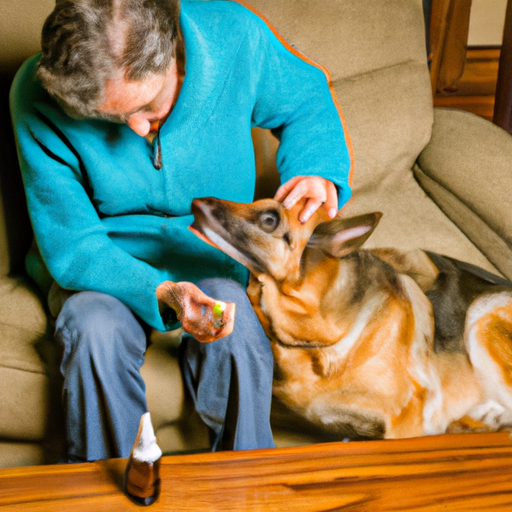As a loving caregiver to your furry friend, it’s heartbreaking to watch them struggle with hip pain. Pain that was once a distant thought in their joy-filled, tail-wagging days can become a harsh reality as they age or if they are prone to certain genetic conditions. But don’t lose heart just yet. There are various ways to manage your dog’s hip pain, from simple lifestyle changes to medications and supplements that can greatly improve their quality of life.
Table of Contents
- Understanding Hip Pain in Dogs
- Causes of Hip Pain
- Symptoms of Hip Pain
- Treatment Options
- Natural Remedies
- Diet and Exercise Tips
- Frequently Asked Questions
Key Takeaways:
– Hip pain in dogs can be caused by various factors, including aging, obesity, and genetic predispositions.
– It’s crucial to recognize the symptoms of hip pain in dogs, which include difficulty moving, limping, and loss of muscle mass.
– There are several treatment options available, such as medication, surgery, and dietary changes.
– Natural remedies like massage and acupuncture can also be beneficial.
– A balanced diet and regular exercise can help prevent hip pain and improve a dog’s overall health.
Understanding Hip Pain in Dogs
The hip is a ball and socket joint that allows for a wide range of movement. When this joint becomes damaged or inflamed, it can result in hip pain. In dogs, hip pain is a common problem, especially in larger breeds and older dogs. This pain can be debilitating, affecting the dog’s mobility and overall quality of life.
Canine hip dysplasia, a genetic condition where the joint develops abnormally, is one of the most common causes of hip pain in dogs. It can lead to arthritis, a condition characterized by painful inflammation and stiffness of the joints.
Causes of Hip Pain
Several factors can contribute to hip pain in dogs. These include:
- Aging: As dogs grow older, their joints naturally degenerate, leading to conditions such as osteoarthritis.
- Obesity: Excess weight puts additional pressure on the joints, leading to wear and tear and ultimately, pain.
- Genetic predisposition: Certain breeds are more prone to developing hip dysplasia and other joint-related conditions.
- Injury or trauma: Injuries can cause acute or chronic pain in the hip joint.
- Infections or disease: Diseases like Lyme can affect the joints, leading to pain and inflammation.
Symptoms of Hip Pain
Knowing the signs of hip pain can help you identify when your dog is in discomfort. Symptoms to look out for include:
- Difficulty getting up or climbing stairs
- Limping or favoring one leg
- Loss of muscle mass in the hind legs
- Decreased activity or reluctance to run, jump, or play
- Changes in behavior such as aggression or withdrawal
Treatment Options
If you suspect your dog is suffering from hip pain, it’s important to consult a veterinarian. They can diagnose the cause of the pain and recommend suitable treatment options. These might include:
- Pain medication: Nonsteroidal anti-inflammatory drugs (NSAIDs) are commonly used to relieve pain and inflammation.
- Surgery: In severe cases, a vet may recommend surgery to improve joint function.
- Physical therapy: This can help improve mobility and strength.
- Weight management: If your dog is overweight, losing weight can relieve pressure on the joints.
Natural Remedies
In addition to traditional treatments, there are also natural remedies that can help manage hip pain in dogs. For instance, massage can help alleviate pain and improve mobility, while acupuncture has been shown to reduce pain and inflammation.
Supplements like glucosamine and chondroitin can also promote joint health. These substances are naturally found in cartilage and can help repair damaged tissue and reduce pain.
Diet and Exercise Tips
A balanced diet and regular exercise are crucial for maintaining your dog’s joint health. A diet rich in omega-3 fatty acids can help reduce inflammation, while regular, low-impact exercise like swimming can strengthen muscles and improve joint flexibility.
Remember, it’s always best to consult with your vet before making any major changes to your dog’s diet or exercise routine.
Frequently Asked Questions
-
What breeds are most prone to hip pain?
Larger breeds like German Shepherds, Labradors, and Great Danes are more prone to hip dysplasia and subsequent hip pain. However, any breed can develop hip problems. -
Can hip pain in dogs be cured?
While some causes of hip pain can be cured, others, like hip dysplasia and arthritis, can only be managed. Early detection and treatment can significantly improve a dog’s quality of life. -
How can I prevent hip pain in my dog?
Regular vet check-ups, a healthy diet, regular exercise, and maintaining a healthy weight can all help prevent hip pain. -
Can a dog live a normal life with hip dysplasia?
With proper management and treatment, a dog with hip dysplasia can live a comfortable life. Treatment may include medication, physical therapy, lifestyle changes, and in some cases, surgery.
For more detailed information, you may find these articles from onetopdog.com helpful:
– Understanding Joint Health in Dogs
– Exercises for Dogs with Hip Dysplasia
– Diet Tips for Dogs with Arthritis
As a caregiver, your role in managing your dog’s hip pain is crucial. With the right knowledge and resources, you can help alleviate their discomfort and improve their quality of life.



